How Did Structure Form in the Universe?
Astronomers observe considerable structure in the universe, from stars to galaxies to clusters and superclusters of galaxies. The famous "Deep Field Image" taken by the Hubble Space Telescope, shown below, provides a stunning view of such structure. How did these structures form? The Big Bang theory is widely considered to be a successful theory of cosmology, but the theory is incomplete. It does not account for the needed fluctuations to produce the structure we see. Most cosmologists believe that the galaxies that we observe today grew from the gravitational pull of small fluctuations in the nearly-uniform density of the early universe. These fluctuations leave an imprint in the cosmic microwave background radiation in the form of temperature fluctuations from point to point across the sky. The WMAP satellite measures these small fluctuations in the temperature of the cosmic microwave background radiation and in turn probe the early stages of structure formation.
Hubble Deep Field Image:
HST press release describing this image
In its simplest form, the Big Bang theory assumes that matter and radiation are uniformly distributed throughout the universe and that general relativity is universally valid. While this can account for the existence of the cosmic microwave background radiation and explain the origin of the light elements, it does not explain the existence of galaxies and large-scale structure. The solution of the structure problem must be built into the framework of the Big Bang theory.
GRAVITATIONAL FORMATION OF STRUCTURE
Most cosmologists believe that the galaxies that we observe today grew gravitationally out of small fluctuations in the density of the universe through the following sequence of events:
- When the universe was one thousandth its present size (roughly 500,000 years after the Big Bang), the density of matter in the region of space that now contains the Milky Way, our home galaxy, was perhaps 0.5% higher than in adjacent regions. Because its density was higher, this region of space expanded more slowly than surrounding regions.
- As a result of this slower expansion, its relative over-density grew. When the universe was one hundredth its present size (roughly 15 million years after the Big Bang), our region of space was probably 5% denser than the surrounding regions.
- This gradual growth continued as the universe expanded. When the universe was one fifth its present size (roughly 1.2 billion years after the Big Bang), our region of space was probably twice as dense as neighboring regions. Cosmologists speculate that the inner portions of our Galaxy (and similar galaxies) were assembled at this time. The stars in the outer regions of our Galaxy were probably assembled in the more recent past. Some cosmologists suspect that some of the objects recently detected by the Hubble Space Telescope may be galaxies in formation.
HST Images of Galaxies in Formation?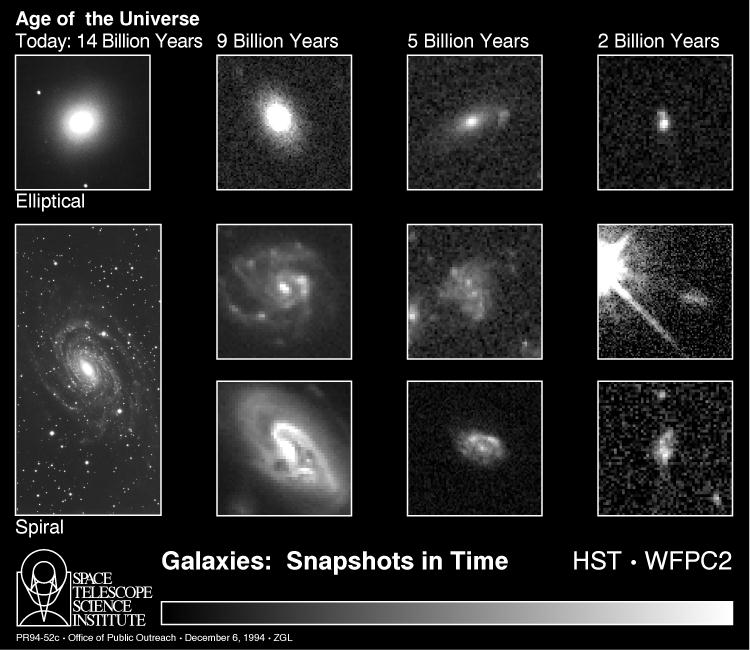
HST press release describing this image
OBSERVING THESE SMALL FLUCTUATIONS
Tiny variations in the density of matter in the early universe leave an imprint in the cosmic microwave background radiation in the form of temperature fluctuations from point to point across the sky. These temperature fluctuations are minute: one part of the sky might have a temperature of 2.7251 Kelvin (degrees above absolute zero), while another part might have a temperature of 2.7249 Kelvin. NASA's Cosmic Background Explorer (COBE) satellite, has detected these tiny fluctuations on large angular scales. WMAP re-measures the fluctuations with both higher angular resolution and sensitivity. The mission summary page offers a quick introduction to how WMAP achieves this sensitivity - more details are available on the technical information page.
WHAT MADE THESE SMALL FLUCTUATIONS?
While gravity can enhance the tiny fluctuations seen in the early universe, it can not produce these fluctuations. Cosmologists speculate about the new physics needed to produce the primordial fluctuations that formed galaxies. Two popular ideas are:
- Inflation
- Topological Defects
These different theories make very different predictions about the properties of the cosmic microwave background fluctuations. For example, the inflationary theory predicts that the largest temperature fluctuations should have an angular scale of one degree, while the defect models predict a smaller characteristic scale. WMAP, with its superb sensitivity, indicates that the inflationary model is more likely.
Fluctuations in the Cosmic Microwave Background
The cosmic microwave background is the afterglow radiation left over from the hot Big Bang. Its temperature is extremely uniform all over the sky. However, tiny temperature variations or fluctuations (at the part per million level) can offer great insight into the origin, evolution, and content of the universe.
If you were approaching the Earth on a spaceship, the first thing you would notice is that the planet is spherical. As you drew closer to the Earth, you would see the surface divide into continents and oceans. You would need to study the Earth's surface very carefully to see the mountains, cities, forests and deserts that cover the continents.
Similarly, when cosmologists first looked at the microwave sky, thirty years ago, they noticed it was nearly uniform. As observations improved, they detected the dipole anisotropy. Finally, in 1992, the Cosmic Background Explorer (COBE) satellite made the first detection analogous to seeing "mountains on the surface of the Earth": it detected cosmological fluctuations in the microwave background temperature. Several members of the WMAP science team help lead the COBE program and build the spacecraft. COBE's detection was confirmed by the Far InfraRed Survey (FIRS) balloon-borne experiment.
| Fluctuations seen by COBE | Fluctuations seen by WMAP |
|---|---|
 |  |
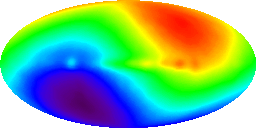 | 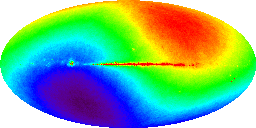 |
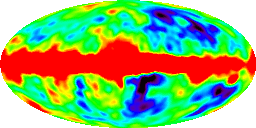 | 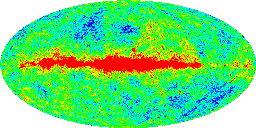 |
In the comparison of the images above, images on the left produced by the COBE science team, show three false color images of the sky as seen at microwave frequencies. The images on the right show one of our computer simulations of what the WMAP experiment detects. Note that WMAP detects much finer features than are visible in the COBE maps of the sky. This additional angular resolution allows scientists to infer a great deal of additional information, beyond that supplied by COBE, about conditions in the early universe.
The orientation of the maps are such that the plane of the Milky Way runs horizontally across the center of each image. The top pair of figures show the temperature of the microwave sky in a scale in which blue is 0 Kelvin (absolute zero) and red is 4 Kelvin. Note that the temperature appears completely uniform on this scale. The actual temperature of the cosmic microwave background is 2.725 Kelvin. The middle image pair show the same map displayed in a scale such that blue corresponds to 2.721 Kelvin and red is 2.729 Kelvin. The "yin-yang" pattern is the dipole anisotropy that results from the motion of the Sun relative to the rest frame of the cosmic microwave background. The bottom figure pair shows the microwave sky after the dipole anisotropy has been subtracted from the map. This removal eliminates most of the fluctuations in the map: the ones that remain are thirty times smaller. On this map, the hot regions, shown in red, are 0.0002 Kelvin hotter than the cold regions, shown in blue.
There are two main sources for the fluctuations seen in the last figure:
- Emission from the Milky Way dominates the equator of the map but is quite small away from the equator.
- Fluctuating emission from the edge of the visible universe dominates the regions away from the equator.
- There is also residual noise in the maps from the instruments themselves, but this noise is quite small compared to the signals in these maps.
These cosmic microwave temperature fluctuations are believed to trace fluctuations in the density of matter in the early universe, as they were imprinted shortly after the Big Bang. This being the case, they reveal a great deal about the early universe and the origin of galaxies and large scale structure in the universe.
What is the Inflation Theory?
The Inflation Theory proposes a period of extremely rapid (exponential) expansion of the universe during its first few moments. It was developed around 1980 to explain several puzzles with the standard Big Bang theory, in which the universe expands relatively gradually throughout its history.
LIMITATIONS OF THE BIG BANG THEORY
While the Big Bang theory successfully explains the "blackbody spectrum" of the cosmic microwave background radiation and the origin of the light elements, it has three significant problems:
- The Flatness Problem:
WMAP has determined the geometry of the universe to be nearly flat. However, under Big Bang cosmology, curvature grows with time. A universe as flat as we see it today would require an extreme fine-tuning of conditions in the past, which would be an unbelievable coincidence. - The Horizon Problem:
Distant regions of space in opposite directions of the sky are so far apart that, assuming standard Big Bang expansion, they could never have been in causal contact with each other. This is because the light travel time between them exceeds the age of the universe. Yet the uniformity of the cosmic microwave background temperature tells us that these regions must have been in contact with each other in the past. - The Monopole Problem:
Big Bang cosmology predicts that a very large number of heavy, stable "magnetic monopoles" should have been produced in the early universe. However, magnetic monopoles have never been observed, so if they exist at all, they are much more rare than the Big Bang theory predicts.
THE INFLATION THEORY
The Inflation Theory, developed by Alan Guth, Andrei Linde, Paul Steinhardt, and Andy Albrecht, offers solutions to these problems and several other open questions in cosmology. It proposes a period of extremely rapid (exponential) expansion of the universe prior to the more gradual Big Bang expansion, during which time the energy density of the universe was dominated by a cosmological constant-type of vacuum energy that later decayed to produce the matter and radiation that fill the universe today.
Inflation was both rapid, and strong. It increased the linear size of the universe by more than 60 "e-folds", or a factor of ~10^26 in only a small fraction of a second! Inflation is now considered an extension of the Big Bang theory since it explains the above puzzles so well, while retaining the basic paradigm of a homogeneous expanding universe. Moreover, Inflation Theory links important ideas in modern physics, such as symmetry breaking and phase transitions, to cosmology.
HOW DOES INFLATION SOLVE THESE PROBLEMS?
- The Flatness Problem:
Imagine living on the surface of a soccer ball (a 2-dimensional world). It might be obvious to you that this surface was curved and that you were living in a closeduniverse. However, if that ball expanded to the size of the Earth, it would appear flat to you, even though it is still a sphere on larger scales. Now imagine increasing the size of that ball to astronomical scales. To you, it would appear to be flat as far as you could see, even though it might have been very curved to start with. Inflation stretches any initial curvature of the 3-dimensional universe to near flatness. - The Horizon Problem:
Since Inflation supposes a burst of exponential expansion in the early universe, it follows that distant regions were actually much closer together prior to Inflation than they would have been with only standard Big Bang expansion. Thus, such regions could have been in causal contact prior to Inflation and could have attained a uniform temperature. - The Monopole Problem:
Inflation allows for magnetic monopoles to exist as long as they were produced prior to the period of inflation. During inflation, the density of monopoles drops exponentially, so their abundance drops to undetectable levels.
As a bonus, Inflation also explains the origin of structure in the universe. Prior to inflation, the portion of the universe we can observe today was microscopic, and quantum fluctuation in the density of matter on these microscopic scales expanded to astronomical scales during Inflation. Over the next several hundred million years, the higher density regions condensed into stars, galaxies, and clusters of galaxies.
